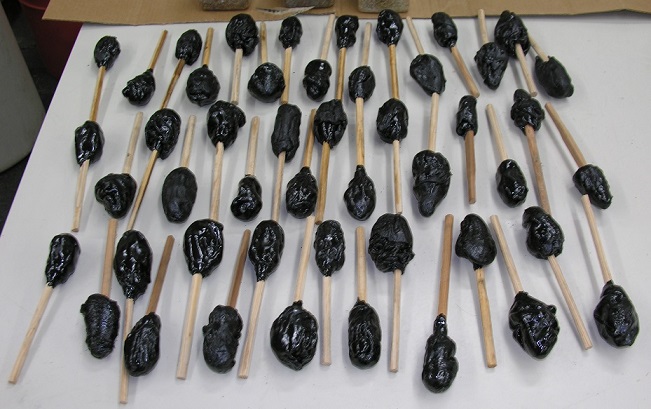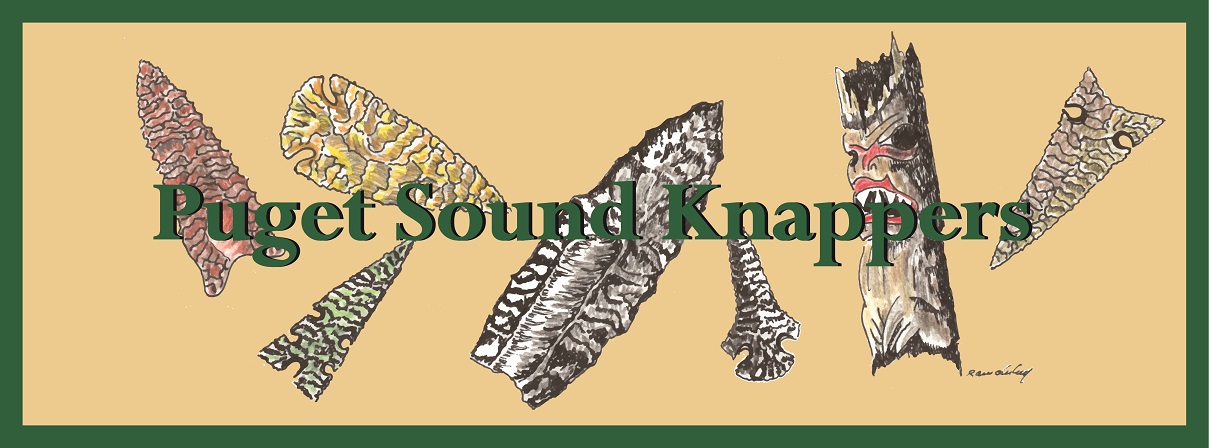|
Instructions on Making Pine Pitch Glue
James C. Keffer

Pine pitch glue has been used for centuries by people throughout the world to help attach projectile points and knife blades to a variety of shafts/handles. Made properly is works quite well to attach blades or points of stone, bone, wood, ivory, etc, to handles or shafts made of wood, antler or bone. When coupled with sinew, pine pitch glued points, more often than not, will break before detaching.
The pitch from most Pine/Fir trees will make excellent glue. To collect pine pitch one needs only to walk through a pine/fir forest and look for damaged trees where the sap has started to ooze out. Whether it is soft or already hard, all of the pitch can be converted into glue. Simply scrap or break the pitch off into a disposable container. When in the woods I usually just carry around a couple of plastic bags or Ziploc baggies. I use one baggie as a 'glove' and the other to hold the pitch. Be careful, getting the pitch off of hands and clothes can be a pain.
To Make Pine Pitch Glue
Ingredients:
Pine/Fir pitch (sap) Charcoal – finely chopped Plant fibers(1/8" or 3.175mm) – or coarse manure
1. Once you collect enough pine pitch you’ll need to heat it to remove the ‘volatiles’ (turpentine). You must heat the pine pitch to the point where the turpentine evaporates away. Some say to bring the pitch to a low boil for a few minutes and others recommend just a low simmer for 5-6 minutes. Both work but the boiling is faster. Be sure and use a container large enough that it won't boil over or spill.
2. I filter the hot, liquid pitch through a layer or two of cheese cloth. Pine pitch, especially if you find large deposits of old pitch, usually contains bugs, moss, twigs and other debris. These can make the glue inferior and much less attractive when you apply it to an arrow or knife.
3. Make some charcoal and grind it into a fine powder. I use hardwoods - Big Leaf Maple, Western Red Alder or Oregon White Ash as they are readily available in the PNW and make excellent charcoal.
But any clean-burning hardwood will work, just stay away from pitch-heavy firs and pines. Find some dry limbs, cut into 2" chunks and put in a metal container that has a tight fitting lid (5 - gallon metal paint bucket works great). Drill a 1/8" hole in the lid. Build a fire under the maple (I just use cedar kindling) and get the fire going really well. I actually use a leaf blower to get the fire going really hot and blazing. Once all the maple has started to burn really well, place the lid on the container and wait until the fire burns out and the container is cool to the touch. If you can't make your own charcoal the make sure you get chunk charcoal, not the briquettes. They almost always contain petroleum products and can ruin your glue.
4. Take the cool charcoal out and grind it into as fine a powder as you can. I have a great method - I put two dozen 2 oz lead balls and some steel ball-bearings in my tumbler with real small chunks of charcoal and 20 minutes later I have charcoal as fine as can be!
5. I mix the charcoal into the hot liquid pitch in about a 50% pitch/50% charcoal (by volume) ratio or until it starts to feel like soft clay. I've experimented with as little as 10% charcoal and found that the more charcoal
the more the glue will harden and the more it will resist softening. During experiments at Rabbitsick Primitive Skills Gathering class I taught, the 50/50 ratio glue did not soften at all whe
exposed to direct sunlight and 80 degree temperature for an entire day. We also found that less charcoal produced stickier glue that was slightly more susceptable to sunlight.
Some people recommend adding some plant fiber - usually very dry manure (such as elk droppings), coarsely ground between the hands but not finely ground. I do this as well as it seems to give the glue a little more strength.
But I add only about 5%- 10% manure/plant fiber to the pitch/charcoal mixture. I've recently experimented with other plant fiber that have not gone through any digestive tract.
I limited my tests to plant fibers suitable for cordage; dogbane, thistle, yucca, stinging nettle, hemp and flax. In my experiments they work better than manure fibers of the same size.
They definitely seem to strengthen the glue.
You have to mix all three ingredients together at the same time while the pitch is still liquid. It will start to cool and harden fairly quickly.
6. Most people I know make 'dubbing/daubing' sticks. Take a pencil size stick and coat it with the finished pine pitch glue by rolling one end of the stick around in the glue until you have a glob about the size of a walnut on the stick. You can then use the daubing stick like a stick of ferrule cement, just heat and apply.
7. You can also store just the clarified pitch by pouring into a small can such as a 6 oz tuna can. To make storing even easier, once the pitch hardens I cut/peel away the can and place the pitch in a plastic Ziploc baggie. Just be sure and store in a cool place.
Last tips - for appearances sake, I always mask off the areas I don't want to get glue on with tape. And I always have some turpentine on hand for clean-up. Turpentine works the best.
If you do this right, the glue, when applied, will harden like JB-Weld and work great. If you make a mistake you can re-heat the glue and start over. Note - do not leave a pine pitch glued object in really hot sun, it will soften and stick to whatever it touches.
|

